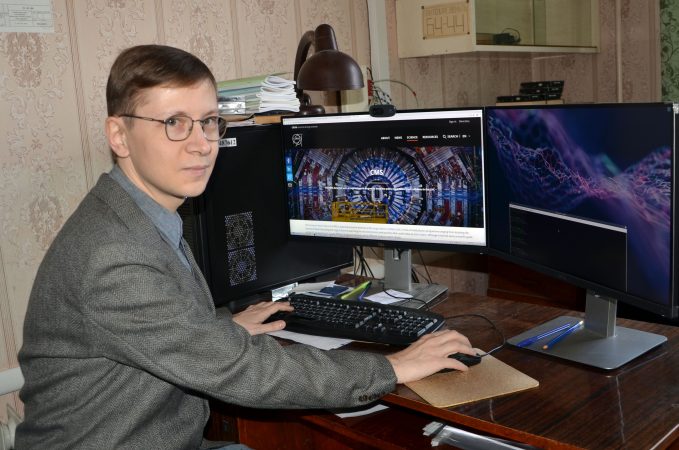Supporting Ukrainian scientists' participation in fundamental research
Published: 20 June 2019

Alexey Kurov (pictured), research associate at the Kharkiv Institute of Physics and Technology (KIPT), is part of the only Ukrainian team that is processing data from the Large Hadron Collider in CERN.
Alexey Kurov is actively involved in processing data from the Large Hadron Collider’s Compact Muon Solenoid (CMS) experiment run by CERN, the European Organisation for Nuclear Research.
“It’s a significant contribution by our Institute and Ukraine as a whole to one of the largest experiments… designed to find answers to some of the most important questions for understanding nature”.
Alexey Kurov, research associate at NSC KIPT
The CMS is one of the largest multi-purpose experiments at the site and fulfils an extraordinarily fundamental and extensive research program. In particular, it includes studies of the properties of the Higgs boson particle, which was discovered in the experiment in 2012, and a search for particles that could contribute to the dark matter of the Universe.
Alexey is aware of the importance of his work, which has been boosted by improved network connectivity thanks to URAN Association, the Ukrainian NREN, and the EU-funded EaPConnect project.
Here Alexey talks about his work – and the inevitable difficulties that need to be overcome when taking on such large-scale projects.
What do you do at KIPT and how does your activity contribute to KIPT participation in CERN experiments?
By background, I am a theoretical physicist. I started studying waves in plasmas in 2000 and since 2015, I’ve been part of the group participating in the CMS experiment at the Large Hadron Collider (LHC) at CERN. The main task of the group is to support processing of experimental information from the LHC on our computing facility.
What challenges have you faced in carrying out this job?
It’s important to emphasise that the processing of data from the LHC is performed almost continuously (24 hours a day, 7 days a week). So, we must provide a high level of reliability at the facility. This is no simple task: it’s necessary to constantly monitor the operation of the facility and ensure the proper functioning of the sophisticated specialised software. Our facility is the only active Ukrainian computing centre involved in the CMS data processing, and to provide a high level of reliability is of key importance to us.
What difficulties for KIPT research activities have these challenges caused in the past?
The requirements for the external communication channels of the computing facilities involved (like ours) in the distributed processing of the CMS data are extremely high. First, sufficiently high external network throughput is needed to provide the transfer of large amounts of experimental information. Unfortunately, our channels did not have the needed capacity, so we could not achieve the required efficiency of data processing at the facility.

In addition to this, traffic should be routed using non-commercial networks (dedicated for use by research and educational organisations) both in Europe and abroad such as GÉANT in Europe and Internet2 and ESnet in the USA. We could not resolve this problem on our own and so we went to the NREN of Ukraine, URAN Association, for help.
What help did you get from URAN?
URAN’s collaboration with GÉANT and with our academic ISP, Uarnet, ensured that we were able to gain access to the LHCONE (Large Hadron Collider Open Network Environment) network infrastructure. This is exclusively used for transfers of large amounts of experimental data obtained at the LHC. This access provided by URAN assured a low percentage of packet loss, optimal routing and, most importantly, the network bandwidth needed for data exchange. This has reduced the number of errors in data transmission and, accordingly, improved the quality of our facility operation.
How has this help from URAN promoted your work?
The experience in setting up and operating the communication channel, as well as the network solutions offered by URAN experts, were extremely useful for me as a specialist. It was also great support for high-quality data processing at our facility.
How has KIPT’s research work with CERN benefitted as a result of these changes?
The implementation of a 10-Gbps communication channel Kyiv-Vienna reduced packet losses, which has improved the quality of data transmission. After setting up the new channel, the amount of data transferred to our computing facility for processing has more than tripled: from 2 to 7.7 Petabytes. This is a significant contribution by our Institute (and Ukraine as a whole) to the CMS experiment, one of the largest experiments at the LHC, designed to find answers to some questions of the great importance for understanding nature.
How do you feel personally about these improvements?
I take pride in my involvement in the outstanding scientific results obtained at the LHC.
Would you like to work more with URAN, if so, how?
Cooperation with URAN experts, in particular with the head of the technical department, was constructive, informative, interesting and very positive. The continuation of the high-quality communication channel provided by URAN and further cooperation with URAN is of great importance for us because this is directly related to the research activities of our laboratory.
Images – NSC KIPT